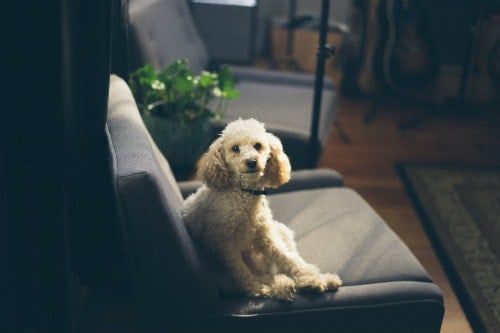We all love our dogs like they’re part of the family, because they are. Our furry family members are as much a part of the family as our loved ones who are human. They show us affection and devotion, and they keep us company during the best of times, and the worst of times. If only we could talk with them, and explain why it’s so important that dogs stay off of furniture.
Protect Your Furniture While Keeping Your Dog Happy
Nobody wants their home’s furniture to smell like dog. But the dog just doesn’t seem to understand it. After spending all afternoon cheerfully chasing the ball in the park, why can’t he jump onto the expensive sectional sofa?
We know why. So you’re determined to figure out a way to keep your dog off the furniture, now you just have to determine how. Here are several techniques, some tips and tricks you can use to keep everybody in the family happy ▬ and in the right place.
How to Keep Your Dogs Off of Furniture Effectively

There are two different methods for training your dog to understand the behavior expectations you have. The first and best way to train your dog, according to the American Kennel Club, or AKC, is to reward your dog’s positive behavior.
The second way, which is often necessary to incorporate into your dog’s training repertoire, is to provide an incentive for your dog to stop an annoying or destructive behavior. Essentially, all dog behavior training comes down to using the “carrot and the stick” method.
Be sure to create and use consistently the reward system you establish for your dog. You’ll get the best and most effective results if you start using these methods when your dog is still a puppy, but you can start using these techniques at any time.
The Key to Success is You as the Dog Owner
The key to achieving success is going to come down to you and your behavior. You want to react to your dog’s behavior with speed and consistency. Why? Your dog is, in a many ways, like a child.
If your dog jumps onto your favorite recliner, she may look over to you quickly to see if she’s getting any response from you. If you react quickly and give her a command, “no,” she’ll realize that you aren’t satisfied with her getting onto the recliner.
The American Kennel Club’s Positive Reinforcement Training
The AKC recommends that you use canine positive reinforcement training. This positive training is based upon your rewarding your dog’s desired behavior quickly, consistently, and with a small reward. The reward can be something like a small piece of kibble, or by giving your dog a small toy he really likes to play with.
React Quickly To Good Behavior

The most important element of this positive training is that you respond immediately after your dog shows the behavior. So let’s bring this back to the furniture scenario. You’ve just caught your dog jumping onto the furniture, so what do you do?
Use Short, One Word Commands
You give a simple and clear command, like “Off.” For your dog to understand you most effectively, you should accompany the voice command with a simple hand gesture that you incorporate consistently, like swiping your hand in a downward gesture.
Your dog responds by jumping off the recliner, and you instantly shower her with loud, high-pitched rewarding praise. “Yes,” or “Good.” For this method to be effective, your reaction has to be immediate and consistent. But the key to this reward, from the dog’s point of view?
Reward Your Dog Immediately and Consistently
The reward. Your dog is looking at you with anticipation in her eyes, expecting her piece of kibble or dog toy. It’s a good idea for you to have a hierarchy of rewards to use for your dog.
Your rewards can be as simple as some giving your dog kibble or petting your dog. Keep in mind that your dog is inherently motivated to keep you happy. In your dog’s eyes, your the alpha and the leader of his pack.
Your Dog Wants You to be Happy
Your dog wants you to be satisfied with his behavior and will do almost anything to make you happy. However, it’s important to remember that a dog can get distracted easily. If you’re training your dog at home and there’s few distractions, you can reward him with a simple
As you move to an environment like the backyard or a public park? You need to up the ante. Let’s say you give him the command of “Come,” and he obeys you perfectly. You want to reward him in that scenario with a bigger
Why? Because for your dog, that’s a harder task to have completed successfully. He worked hard and so he deserves a bigger reward, to his way of thinking.
For your dog training to be most effective, you want to be sure that you incorporate:
- Sight (a visual cue)
- Sound (a command or clicker)
- Smell (the scent of the
treat ) - A Prize (immediate praise and reward)
As long as you reward your dog for great behavior with consistent praise and a treasured reward, he will respond to your commands. How does help keep your dog off the furniture?
You can use positive reinforcement training to teach your dog to stay on the floor, which is a positive behavior. It works easier and better than teaching him to stay off the furniture, which is a boundary and a therefore inherently negative.
Start Good Doggy Habits Up Front

In summary, it’s easier to tell your dog the right thing to do than to teach him to stop doing something wrong. But let’s now look at the other scenario.
Let’s say you’re already there; the dog’s already constantly jumping onto furniture like he owns the place. Now what do you do to keep your dogs off the furniture?
The same techniques that work for positive behavior training can work to teach your dog what not to do. You want to make a piece of furniture that your dog just loves as an unattractive as possible.
Just as we uses the dog’s five senses to train him what he should do, you will use again to teach him to stay off of furniture. We’re going to use sight, sound, smell, touch and taste.
Tips to Make Your Dog Want to Keep Off of Furniture
All of these dog training techniques are simple and effective. You want to start with one and try it for a few weeks, and see your results. If your dog’s behavior has changed, then that’s fantastic. You’ve found success.
If you’re getting the results you want, stick with that particular technique. If you still want further changes, then try another dog training technique.
However, it’s important that you try only one dog training technique at a time. Remember that your dog is a lot like a human child, and he wants you to be pleased. Similar to a human child, your dog gets confused if you don’t keep consistent boundaries and rewards.
Deterrents to Use to Keep Dogs Off of Furniture

1. Shake Can – Many dogs hate to be startled by a sudden, unexpected noise. Dogs especially hate a loud noise that’s not anticipated. Be sure to use this knowledge to create a deterrent.
Just as before, the key to success is you and your behavior. You have to catch your dog immediately when he jumps onto the furniture. So what do you do when he jumps onto the sofa, recliner or bed that you want him to stay off?
Shake the can immediately and loudly. It’s easy to make a shake can by just putting something like pennies or pebbles into an aluminum can. Be sure you don’t fill the can to the top, because it will rattle less.
2. Sour Apple Spray – To protect your furniture and keep your dogs off of furniture, try buying some sour apple spray. Dogs and cats alike have a strong taste receptor toward the taste of sour than we do as humans.
To protect your furniture and make it unappealing to your dogs, spray some sour apple spray onto a towel and lay it on the surface you want to protect. Your dog should hate it and avoid the area. Keep in mind that you have to respray the scent every day or two until your dog’s behavior has changed.
3. Try aluminum foil. Dogs hate the feel of aluminum foil, so try spreading some foil over the furniture surfaces. When your dog jumps up onto the furniture, the feel of the foil and the startling sound will scare your dog a little. It should make the furniture unappealing to him and he’ll stay away.
4. Use an electric-shock dog training pad. If none of the other training techniques work to keep your dogs off of the furniture, you can try the electric shock pads. You can purchase these at a pet store or online, and don’t be concerned. They only provide a small, quick shock to your pet.
Similar to the aluminum foil, you place the training pad on the furniture surface you want to keep the dog away from. When the dog jumps onto the furniture, he’ll receive a momentary shock, and it will act as a deterrent. Soon, he will avoid the furniture completely.
Remember to Reward Your Dog When He Jumps Off Furniture
When you incorporate all these dog training techniques, you will be able to shape your behavior. Remember, that the key is you – and your quick reward. Once your dog jumps off the furniture, praise him immediately and give him a
Using these dog training techniques, you will soon have the dog of your dreams – and furniture that looks nice. Take the time to enjoy both your incredible dog and home, and you’re be glad you did.
